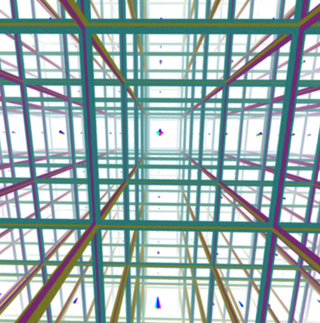
In mathematics, a diffeomorphism is an isomorphism of smooth manifolds. It is an invertible function that maps one differentiable manifold to another such that both the function and its inverse are differentiable.

In mathematics, topology is concerned with the properties of a geometric object that are preserved under continuous deformations, such as stretching, twisting, crumpling, and bending; that is, without closing holes, opening holes, tearing, gluing, or passing through itself.
In mathematics and statistics, a piecewise linear, PL or segmented function is a real-valued function of a real variable, whose graph is composed of straight-line segments.

In mathematics, low-dimensional topology is the branch of topology that studies manifolds, or more generally topological spaces, of four or fewer dimensions. Representative topics are the structure theory of 3-manifolds and 4-manifolds, knot theory, and braid groups. This can be regarded as a part of geometric topology. It may also be used to refer to the study of topological spaces of dimension 1, though this is more typically considered part of continuum theory.
In geometric topology and differential topology, an (n + 1)-dimensional cobordism W between n-dimensional manifolds M and N is an h-cobordism if the inclusion maps
In geometric topology, a field within mathematics, the obstruction to a homotopy equivalence of finite CW-complexes being a simple homotopy equivalence is its Whitehead torsion which is an element in the Whitehead group. These concepts are named after the mathematician J. H. C. Whitehead.

In mathematics, a 3-manifold is a space that locally looks like Euclidean 3-dimensional space. A 3-manifold can be thought of as a possible shape of the universe. Just as a sphere looks like a plane to a small enough observer, all 3-manifolds look like our universe does to a small enough observer. This is made more precise in the definition below.

In mathematics, triangulation describes the replacement of topological spaces by piecewise linear spaces, i.e. the choice of a homeomorphism in a suitable simplicial complex. Spaces being homeomorphic to a simplicial complex are called triangulable. Triangulation has various uses in different branches of mathematics, for instance in algebraic topology, in complex analysis or in modeling.

In mathematics, a manifold is a topological space that locally resembles Euclidean space near each point. More precisely, an -dimensional manifold, or -manifold for short, is a topological space with the property that each point has a neighborhood that is homeomorphic to an open subset of -dimensional Euclidean space.
In mathematics, a piecewise linear (PL) manifold is a topological manifold together with a piecewise linear structure on it. Such a structure can be defined by means of an atlas, such that one can pass from chart to chart in it by piecewise linear functions. This is slightly stronger than the topological notion of a triangulation.
In mathematics, more specifically in geometric topology, the Kirby–Siebenmann class is an obstruction for topological manifolds to allow a PL-structure.
In mathematics, algebraic spaces form a generalization of the schemes of algebraic geometry, introduced by Michael Artin for use in deformation theory. Intuitively, schemes are given by gluing together affine schemes using the Zariski topology, while algebraic spaces are given by gluing together affine schemes using the finer étale topology. Alternatively one can think of schemes as being locally isomorphic to affine schemes in the Zariski topology, while algebraic spaces are locally isomorphic to affine schemes in the étale topology.
In mathematics, Dehn's lemma asserts that a piecewise-linear map of a disk into a 3-manifold, with the map's singularity set in the disk's interior, implies the existence of another piecewise-linear map of the disk which is an embedding and is identical to the original on the boundary of the disk.

In mathematics, a space is a set with some added structure.
James Raymond Munkres is a Professor Emeritus of mathematics at MIT and the author of several texts in the area of topology, including Topology, Analysis on Manifolds, Elements of Algebraic Topology, and Elementary Differential Topology. He is also the author of Elementary Linear Algebra.
In the mathematical area of topology, the generalized Poincaré conjecture is a statement that a manifold which is a homotopy sphere is a sphere. More precisely, one fixes a category of manifolds: topological (Top), piecewise linear (PL), or differentiable (Diff). Then the statement is
In mathematics, specifically geometry and topology, the classification of manifolds is a basic question, about which much is known, and many open questions remain.

In mathematics, more specifically in differential geometry and topology, various types of functions between manifolds are studied, both as objects in their own right and for the light they shed
In mathematics, the Schoenflies problem or Schoenflies theorem, of geometric topology is a sharpening of the Jordan curve theorem by Arthur Schoenflies. For Jordan curves in the plane it is often referred to as the Jordan–Schoenflies theorem.

Morris William Hirsch is an American mathematician, formerly at the University of California, Berkeley.










